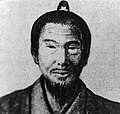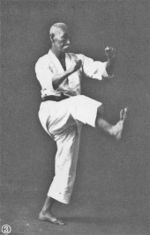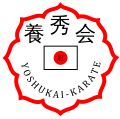Chatan Yara Kūshankū. There is a theory that Kūsankū originated with Kōshōkun (Okinawan dialect: Kūsankū), who visited Okinawa during the Ryukyu Kingdom...
4 KB (492 words) - 12:07, 30 August 2024
Kūsankū (クーサンクー) or Kōshōkun (公相君) was a Chinese martial artist who is said to have visited Okinawa during the Ryukyu Kingdom in the mid-18th century...
4 KB (442 words) - 20:21, 13 August 2024
Kanken Tatsuo Shimabuku Important kata: Naihanchi sanchin (Shuri-te) Pinan Kūsankū Passai Jion Jitte Rohai Chinto Gojushiho The successor styles to Shuri-te...
6 KB (663 words) - 10:42, 28 September 2024
Sakugawa Kanga (section Meeting with Kusanku)
that Kangi Sakugawa train under Kusanku, a Chinese master in Ch'uan Fa. Kangi Sakugawa spent six years training with Kusanku, and began to teach his son Kanga...
4 KB (496 words) - 03:52, 9 December 2024
1609), as well as the theory that it was introduced by Kōshōkun (Okinawan: Kūsankū) based on the description in Ōshima Writing. There are also other theories...
116 KB (12,540 words) - 12:03, 9 January 2025
Niseishi, Bassai, Chinto, Sochin, Tenshin, Ro Hai Dai, Sanshiryu, Ryushan, Kusanku, Sanchin 15 kata not including kihon and Bo kihon/kata KishimotoDi Okinawa...
7 KB (396 words) - 22:47, 10 November 2024
of the three most practiced kata in Okinawa, along with Naihanchi and Kūsankū, but was already lost in China at the time. Originally there were two types...
11 KB (1,410 words) - 16:20, 8 January 2025
originated in Okinawa and were adapted by Anko Itosu from older kata such as Kusanku and Channan into forms suitable for teaching karate to young students....
6 KB (690 words) - 13:01, 23 November 2024
Isshin-ryū (section Kusanku (クーシャンク))
in Isshin-Ryu, five come from the teaching of Chotoku Kyan. Kusanku is one of these. Kusanku is often referred to as a "night-fighting" kata, or a form...
38 KB (5,536 words) - 05:13, 17 November 2024
variation practiced in kyokushin. The Kanku kata was originally known as Kusanku or Kushanku, and is believed to have either been taught by, or inspired...
66 KB (6,589 words) - 02:43, 21 December 2024
nidan sandan yondan godan Passai sho dai Gojushiho Dai Ni Gojushiho Chinto Kusanku sho dai Jion The following Kata are not taught in all Shōrin-ryū systems...
10 KB (994 words) - 19:17, 31 October 2024
Shōrin-ryū Seibukan (section Kusanku)
techniques. Kusanku is the longest and most difficult of Sukunaihayashi kata. It is often regarded as the most beautiful kata of the style. Kusanku is the...
14 KB (2,037 words) - 09:48, 2 October 2024
who first developed the Pinan kata, which were possibly derived from the Kusanku form. One of his close friends, Chōjun Miyagi (宮城 長順, Miyagi Chōjun) (founder...
20 KB (2,294 words) - 21:42, 17 September 2024
best students and learned the kata: Seisan, Naihanchi, Wansu, Chinto and Kusanku, along with the weapons kata Tokumine nu kun and basic Sai. He also began...
14 KB (1,875 words) - 10:21, 28 November 2024
Pinan forms were (allegedly) created by drawing from two older forms: kusanku and chiang nan. In Okinawa, it is said Itosu always walked in the Naihanchi...
10 KB (1,247 words) - 15:31, 8 December 2024
as naihanchi I & II, passai, seisan, chintō, gojūshiho, kusanku (the embodiment of kusanku's teaching as passed on to Tode Sakugawa) and hakutsuru. The...
6 KB (657 words) - 15:53, 7 December 2024
Naihanchi Sandan Pinan Shodan, Pinan Nidan, Pinan Sandan, Pinan Yondan, Pinan Godan Kunishi Tomari Seisan Niseishi Motobu Choyu Passai Kentsu Yabu Kusanku...
25 KB (2,423 words) - 01:02, 10 June 2024
Yes Some Yes Yes Yes Yes Yes Juroku Yes Yes Kururunfa Yes Yes Yes Yes Kusanku/Kanku/Bokanku (some: dai and sho versions) Yes Yes Yes Yes Yes Yes Yes...
13 KB (820 words) - 02:26, 21 December 2024
early days were versions of Naihanchin, Nijushiho, Sanchin, Chinto and Kusanku, as well as a Bō (6 ft staff) kata (Shishiryu no Bo), a Jo (4 ft staff)...
13 KB (1,593 words) - 02:05, 10 December 2024
to the Hangeul spelling and varying regional pronunciations (dialect). Kūsankū is used under the name Kong-Sang-Kun. Enpi is used under the name Sei-shan...
52 KB (7,511 words) - 02:05, 22 November 2024
Naihanchi Shodan Naihanchi Nidan Naihanchi Sandan Tomari Seisan Pinan Shodan Pinan Nidan Pinan Sandan Pinan Yondan Pinan Godan Passai Kusanku Niseishi...
6 KB (771 words) - 23:46, 26 April 2024
Chi-i no Kata Jin-i no Kata Sansai Koryū Naifanchi Koryū Bassai Koryū Kusanku There are many more kata mentioned in this book, without pictures, a total...
12 KB (1,700 words) - 05:45, 15 April 2024
first developed the Pinan kata, which were most probably derived from the 'Kusanku' form. One of his close friends, Chōjun Miyagi (宮城長順) (founder of Gōjū-ryū)...
9 KB (1,163 words) - 19:54, 30 August 2024
Naihanchi Ni (Tekki Nidan) Nandan shō (Nijūshiho / Niseishi) Kankū Shō (Kusanku Shō) Tekatana Naihanchi San (Tekki Sandan) Tensho There are other variations...
9 KB (1,103 words) - 00:07, 29 November 2024
Naihanchi series (1-3) Ananku Wankan Rōhai Wanshu Passai Gojūshiho Chintō Kusanku These are the ranks as set out by the World Matsubayashi-ryu (Shorin-ryu)...
12 KB (1,348 words) - 07:52, 16 October 2024
Pinan Sandan, Pinan Yondan, Pinan Godan, Passai Sho, Passai Dai, Kusanku Sho, Chinto, Kusanku Dai, and Gojushiho. Nakazato also created multiple weapons kata...
5 KB (419 words) - 10:17, 28 November 2024
choki motobu ryu kenpo). Ufukun: it's an itosu no kushanku variation. (Kūsankū Dai) Motobu Kenpō is characterized by its emphasis on kumite as well as...
21 KB (2,568 words) - 04:30, 21 December 2024
(1925-2017) dropped the Chatan Yara no Kusanku and the Oyadamari no Passai he learned from Chotoku Kyan and he added Kusanku Sho and Dai and Passai Sho and Dai...
4 KB (394 words) - 02:33, 29 December 2024
無限 Endless Bassai 披塞 To Penetrate a Fortress Chinto 鎮東 Subdue the East Kusanku 公相君 Viewing the Sky/Night Fighting Sanshiryu 三十六歩 Thirty-six Hands/Dragon...
33 KB (4,219 words) - 14:05, 14 September 2024












